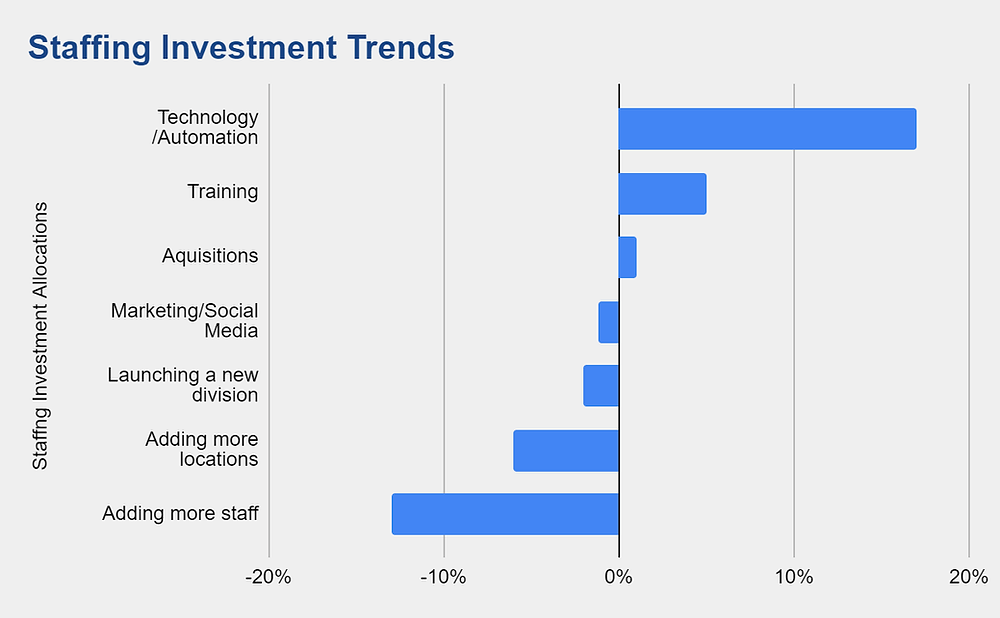According to a recent survey by Staffing Industry Analysts, technology investment has been the largest investment category for staffing suppliers that want to stay competitive. Couple this with COVID layoffs, COVID recovery and the need for employees to be more efficient to control overhead, automation is a crucial reason behind these technology investments.
What is driving these investments?
The healthcare workforce management is much easier said than done. Between managing credentials, privileges, multi-location staffing and multiple provider relationships, a sophisticated approach is required to manage this effectively. Technology that was sufficient in a simpler environment is not competitive today. Deploying the right technologies with an emphasis on automation and collaboration are crucial.
The past year, especially, has seen drastic swings in demand and severe supply limitations---creating a competitive bidding market for some healthcare specialties. Organizations that do not innovate by investing in technology will not survive. Here are only a few ways investments in technology can improve the bottom line:
-
Efficiencies: automation not only improves speed but also eliminates redundant processes
-
Improved visibility
-
Regulatory compliance/risk mitigation
-
Decentralized workforce management
-
Process efficiencies through automation
-
Quality improvements
-
Speed of talent engagement
The key drivers of the adoption of technology for healthcare organizations today are the following:
Gig economy
The gig economy has created an extended workforce using 3rd party and casual providers. A successful platform must be able to identify and manage workers across a large and ever-changing sourcing universe. The best systems create collaboration and visibility across variable relationship sources: direct sourcing, casual relationships, gig communities and of course, agency suppliers.
Intelligent technologies that connect with other platforms
The VMS/ staffing supplier management market has grown over the past decade to now become a $170B market in spend under management. What started as a convenient way to store contingent worker contracts, data and assignment related information has evolved to cross into the ERP services. For an organization to manage the variability of human capital and the ever increasing need for qualified talent, vendor management systems no longer pick up where your ATS left off. The best systems are now able to support a candidate database along with the ability to communicate with internal team members and external staffing agencies; and most importantly, seamlessly manage scheduling, time-keeping and payroll reporting.
Technology adapting to the changing workforce dynamics
How can workforce technologies help?
From giving staffing agencies a better understanding of their available resources to scheduling providers in the most optimal assignments, workforce technologies improve staffing agencies in the following ways:
Optimizing productivity and existing provider relationships
Sharing provider resources across facilities
Better management of open shifts
The need to leverage provider skills across variable departments was especially visible during the pandemic. Modern workforce platforms enable administrators to set broader requirements. The right scheduling technology will help identify additional provider sets and create matches to augment staffing challenges.
A new technology
Another study by SIA (Staffing Industry Analysts) identified key areas for VMS success. Does your VMS software provide these features?
-
Mobile apps for providers AND managers/approvers - no one works at a desk anymore!
-
Predictive spend analytics
-
Automated payroll calculations
-
Integration with other software to reduce redundant data entry
-
Direct shift scheduling
-
Intelligent AI
Kimedics’ software manages your vendor relationships in addition to communicating and scheduling directly with providers from all sources. It allows direct hire and other direct providers to manage their documents, availability and time directly in the application without the need for emails, texts or other outdated methods of communication.
Interested in learning more about how Kimedics can improve your workforce management? Request more information.

